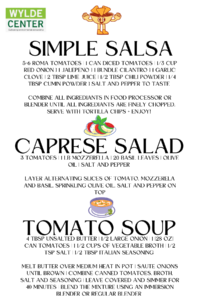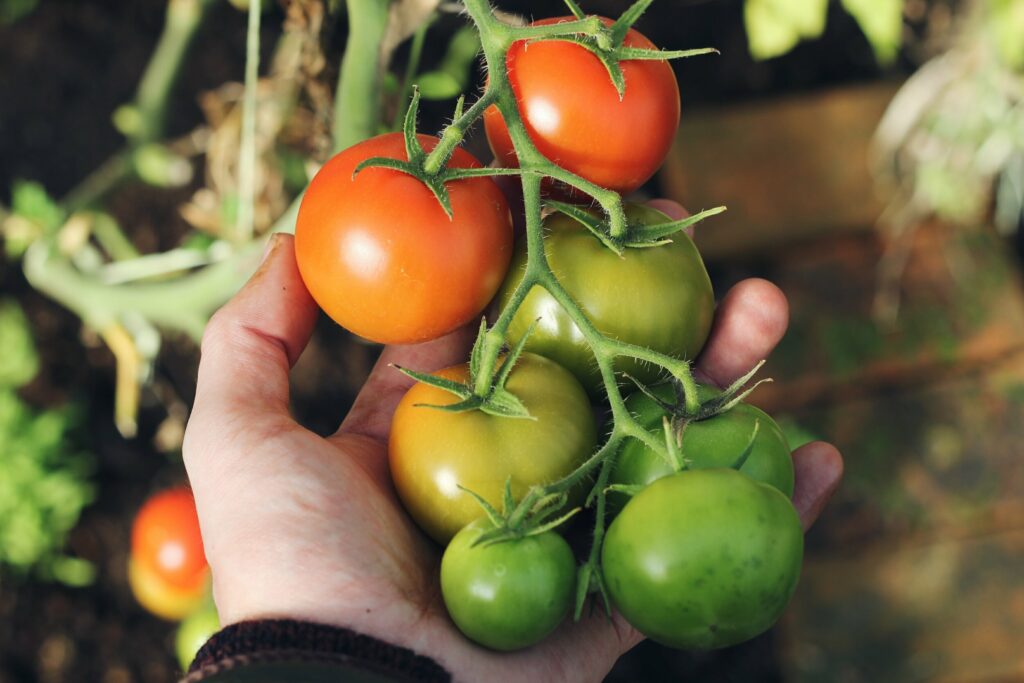By: Tatiana Gonzalez, Farm to School Educator
With a month left of Summer, August in Atlanta is experiencing a hot and humid climate, a favorable environment for one of our favorite harvests of the season: tomatoes!
There is a vast world of different tomato varieties to enjoy – from sungolds, to beefsteak, to cherry tomatoes and romas there are so many ways to savor tomato season. Our favorite ways to connect with tomato season are through planting tomatoes in the garden, experimenting with new recipes, and hosting taste tests with students.
Growing Tomatoes
Tomatoes make an excellent plant for any school, community, or home garden. Their beautiful colors catch the eye and pollinators love their small yellow flowers. Most children and adults can recognize a tomato and connect to it in the garden. Planting tomatoes in the garden can require a small amount of preparation and right timing. Check out our tips to growing successful tomatoes in your garden:
- Start Seeds Indoors: While certain plants in the garden do best by direct sowing, tomatoes are more particular to environmental conditions and do best by starting them in a greenhouse or an indoor seed starting station. Seeding in a greenhouse or indoors can start as early in the year as February (within Zone 7b) and can be transplanted in the garden by March or April, and even into early or mid-Summer.
- Support Plant Growth: Once the tomatoes are planted, since they are a vining plant, it is important that they are supported by some sort of trellis so that they may grow freely and expansively.
- Prevent Dry Soil: Tomatoes are a heat and water loving plant, but in order to make sure that the moisture is conserved in the soil, mulching around the plant would prevent the soil from drying out.
- Companion Planting: Lastly, tomatoes enjoy being planted with some companion plants, such as marigolds and basil, as a means to deter unwanted pests and to add diversity to your garden space.
- Harvesting: Tomatoes will fruit at varying times, depending on when they’re planted and the geographical location, but once they start showing up, make sure to eat them raw, with some olive oil and a pinch of salt, or incorporate them into a nutritious meal.
Tomato Recipes:
The options for using tomatoes in a meal are seemingly endless! From salsa, to pizza, to pasta, to chili, tomatoes are an essential part of everyday cuisine in most places. For some simple recipes, try one of these:


These recipes are versatile for all family members, due to their simplicity, taste and opportunities to engage everyone in the process. Salsa can be adapted to include any additional produce that may be available, such as red bell peppers, or excluding any herbs or produce that may not be favorable for family members, such as the potential soapy flavor of cilantro for certain people. Both salsa and caprese salad can be enjoyed as a meal to cool down from the hot summer days. The caprese salad can also be accompanied with balsamic glaze to enhance the flavor. Lastly, tomato soup can be enjoyed during those rainy evenings when the day has gotten a little cooler and it is time to feel cozy and nourished with loved ones. This simple tomato recipe can be adapted to include any additional herbs or produce, such as parsley or celery. Make sure to engage the little ones when creating these tomato centered meals!
Tomato Taste-test:
A wonderful way to have kids or students connect to the summer season and the garden, is to have a tomato taste test! At the Wylde Center, we feature taste tests during our in-school visits and field trips, where we spend time at the garden and talk about the life cycle of the plant.
- Understand the plant: We ask the students how a tomato grows, and what the different parts of the plant look like. We ask the students to locate the leaves, flowers and fruit, and then we invite everyone to use their five senses before trying a tomato.
- 5 Senses Exploration: We ask the students: “What does it smell like? Does it smell sweet?” and “What does it feel like? Is it rough or smooth? Squishy or hard?” as a means to enhance their interaction with the plant, rather than just relying on taste alone.
- Taste: Eventually, we invite the students to bite into half of the tomato so that they can identify the seeds of the tomato, and bring it back to the importance of connecting with the life cycle.
After a tomato taste test, we usually ask students if they have ever planted seeds in the garden before. This usually brings up a variety of answers, from “My grandma has a garden!” to “No, but I love putting my hands in dirt!” – after opening up the space for students to share their experiences with planting seeds, we then provide every student with a seed that they can plant in the garden. Depending on the season, the option of which seeds to plant may differ.
If there is a desire to stay in line with honoring the tomato plant, tomato seeds can be planted in the garden, just to reinforce the lesson that full grown plants come from seeds, and then we eat the full grown plants, perhaps saving the seeds and starting the cycle all over again.
Sign-up for our Farm to School Newsletter to receive garden tips, recipes, lesson plans, and grant opportunities!
Book your 2023-2024 school programs here.

